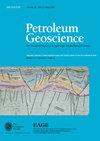Petrographic and Petrophysical Characterization of Pre-salt Aptian Carbonate Reservoirs from The Santos Basin, Brazil
IF 2.1
4区 地球科学
Q3 GEOSCIENCES, MULTIDISCIPLINARY
引用次数: 0
Abstract
Reservoir quality in carbonates is influenced by various factors, such as depositional environment, burial history, and diagenesis processes. Understanding these geological heterogeneities is essential for successful petroleum exploration. This study characterizes Brazilian pre-salt reservoirs and aims to understand how their heterogeneity impacts reservoir quality. We analyzed carbonate samples from the Barra Velha Formation (Santos Basin) through an integration of petrographic and core plug descriptions, petrographic facies characterization, porosity and permeability measurements, and image analysis to identify the principal controls on porosity and permeability, pore size distribution, and groups with similar petrophysical properties using the Hydraulic Flow Unit (HFU) concept. Five facies groups were recognized: Spherulitestone (F1); Shrubstone (F2); Intraclastic Grainstone (F3); Intraclastic Packstone, Spherulitestone with mud and Shrubstone with mud (F4); Shrub-Spherulite Intercalations and Bioclastic Grainstone (F5). The analysis of porosity and permeability showed that their variations are associated with pore type and cementation rate. Greater contribution of inter-aggregate, interparticle, and vugular porosity, combined with a reduced amount of cement, results in higher porosity and permeability, but the increase of cement tends to reduce the porosity and permeability. Among the facies groups, F2 and F3 exhibited the best porosities and permeabilities, followed by F1, F4, and F5. From image analysis, small pores (1.5 x 10 -5 to 0.01 mm²) are the most frequent in all rocks. However, these small pores contributed significantly to total porosity only in F4 and some samples of F3. For F2 and F3, the large pores (from 0.01 mm² to a maximum of 19.62 mm²) are the main contributors, while F5 has a homogeneous contribution. Lastly, the data were grouped into 5 HFUs. HFU1 and HFU2 represent the zones with the best reservoir quality, primarily composed of F2 and F3.巴西桑托斯盆地前盐古生代碳酸盐岩储层的岩相和岩石物理特征描述
碳酸盐岩的储层质量受多种因素的影响,如沉积环境、埋藏历史和成岩过程。了解这些地质异质性对于成功进行石油勘探至关重要。本研究描述了巴西盐前储层的特征,旨在了解其异质性如何影响储层质量。我们分析了来自 Barra Velha Formation(桑托斯盆地)的碳酸盐岩样本,将岩相学和岩心塞描述、岩相面特征描述、孔隙度和渗透率测量以及图像分析结合在一起,利用水力流单元(HFU)概念确定了孔隙度和渗透率的主要控制因素、孔隙大小分布以及具有相似岩石物理特性的组别。确定了五个岩相组:球粒岩(F1);灌木岩(F2);内碎屑粒岩(F3);内碎屑包裹岩、含泥球粒岩和含泥灌木岩(F4);灌木-球粒岩互层和生物碎屑粒岩(F5)。孔隙度和渗透率分析表明,它们的变化与孔隙类型和胶结率有关。集料间孔隙度、颗粒间孔隙度和脉孔隙度越大,加上胶结物用量越少,孔隙度和渗透率就越高,但胶结物用量越多,孔隙度和渗透率就越低。在各面组中,F2 和 F3 的孔隙度和渗透率最好,其次是 F1、F4 和 F5。从图像分析来看,所有岩石中最常见的是小孔隙(1.5 x 10 -5 至 0.01 平方毫米)。然而,只有在 F4 和 F3 的一些样本中,这些小孔隙对总孔隙度的影响很大。在 F2 和 F3 岩石中,大孔隙(从 0.01 平方毫米到最大 19.62 平方毫米)是主要的孔隙度来源,而 F5 岩石的孔隙度来源则很单一。最后,数据被分为 5 个 HFU。HFU1 和 HFU2 代表储层质量最好的区域,主要由 F2 和 F3 组成。
本文章由计算机程序翻译,如有差异,请以英文原文为准。
求助全文
约1分钟内获得全文
求助全文
来源期刊

Petroleum Geoscience
地学-地球科学综合
CiteScore
4.80
自引率
11.80%
发文量
28
审稿时长
>12 weeks
期刊介绍:
Petroleum Geoscience is the international journal of geoenergy and applied earth science, and is co-owned by the Geological Society of London and the European Association of Geoscientists and Engineers (EAGE).
Petroleum Geoscience transcends disciplinary boundaries and publishes a balanced mix of articles covering exploration, exploitation, appraisal, development and enhancement of sub-surface hydrocarbon resources and carbon repositories. The integration of disciplines in an applied context, whether for fluid production, carbon storage or related geoenergy applications, is a particular strength of the journal. Articles on enhancing exploration efficiency, lowering technological and environmental risk, and improving hydrocarbon recovery communicate the latest developments in sub-surface geoscience to a wide readership.
Petroleum Geoscience provides a multidisciplinary forum for those engaged in the science and technology of the rock-related sub-surface disciplines. The journal reaches some 8000 individual subscribers, and a further 1100 institutional subscriptions provide global access to readers including geologists, geophysicists, petroleum and reservoir engineers, petrophysicists and geochemists in both academia and industry. The journal aims to share knowledge of reservoir geoscience and to reflect the international nature of its development.
 求助内容:
求助内容: 应助结果提醒方式:
应助结果提醒方式:


